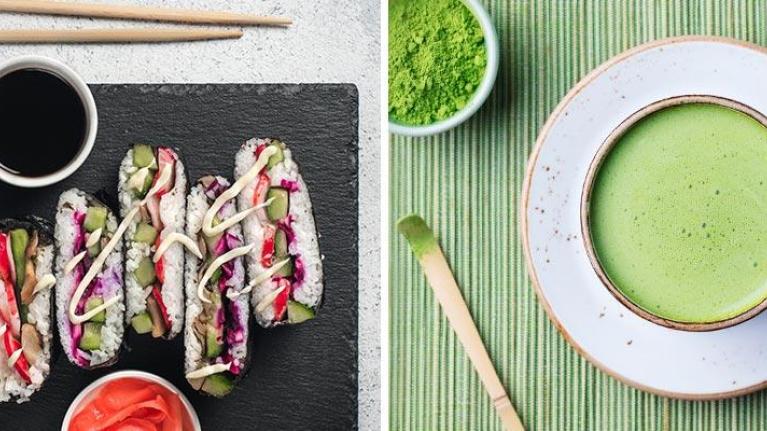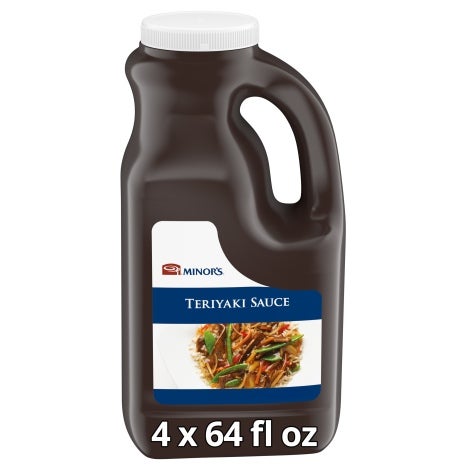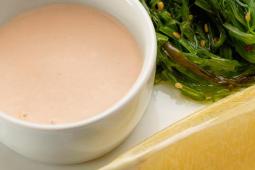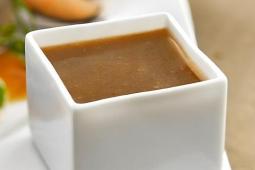
Japanese Hits All the Trend Notes
Intriguing ponzu, miso, and other Japanese flavors are finding their way on to more and more menus. Learn how the trend can work in your operation.
Japanese Translations
There’s more to Japanese food than sushi and ramen. In fact, there are many other Japanese specialties, ingredients, and flavors that can serve as inspiration for mainstream menus. In fact, Japanese food and beverages speak to many current trends, including simplicity, perceived healthiness, flavor principles such as umami, and artisanal production methods including pickling and fermentation.
Katsu, or cutlet in translation, refers to a thin piece of chicken or pork that’s been pounded, dredged and breaded (usually with panko crumbs), and fried. Deliciously light and crispy, it’s often served with a thick, sweet, and savory tonkatsu sauce. Katsu in a sandwich is a natural extension of the ever-popular fried or spicy chicken sandwich trend.
Miso is made from fermented soybeans—or sometimes rice, barley, or other grains—and can range from light, sweet white, or yellow miso to deeply umami red miso. In addition to its uses as a broth for miso soup or ramen noodles, it is often used as a rub for salmon, vegetables (such as eggplant), and other proteins, or in a dressing or sauce.
Bento boxes are compartmentalized bamboo or lacquered trays used to serve several different food items, such as different kinds of sushi or a set-menu lunch. With a retro appeal that calls to mind old-fashioned TV dinner trays or lunch boxes, a bento can be used as a nifty presentation device for a variety of small plates or menu-item components.
Sake kasu are the lees leftover from sake production. In paste form, they can be used as a pickling agent, an ingredient of amazake (a traditional sweet, low-alcohol Japanese drink made from fermented rice), a cooking paste to add flavor to food and as a marinade. Black cod or salmon rubbed with sake kasu before being grilled or roasted is a popular specialty on the West Coast.
Ponzu is a tangy soy-based sauce with the addition of lemon, orange, or another citrus to give it some snap. Traditionally, it also includes mirin, rice wine vinegar, Katsuobushi (dried tuna flakes), and kombu seaweed, which add savory umami notes. Ponzu can be used like a vinaigrette, condiment, or in marinades and glazes, particularly with fish and other delicately flavored proteins and ingredients.
Japanese milk bread (shokupan) has become popular lately in sandwiches and other applications where a soft, springy texture is desired. The dough is somewhat similar to that of brioche, and can be shaped into loaves or individual rolls. The addition of sugar and butter makes milk bread rich and slightly sweet, and it produces excellent toast.
Teriyaki is more than just the well-known sauce made with soy sauce, rice wine, brown sugar, garlic, and ginger. It’s also a cooking technique in which foods such as chicken, fish, and other proteins, as well as vegetables, are glazed with the sauce and then grilled or broiled.
Yakitori refers to skewered chicken, in the strictest sense; in Japan, specialty yakitori shops serve skewered chicken in all its forms, from breast and thigh meat to livers, gizzards, and other “parts,” often cooked over a charcoal grill. Now, skewered meats and vegetables of all kinds, marinated and glazed with different flavorings, are being touted in mainstream restaurants for their simple, ingredient-focused concept.
Onigiri rice balls could be the next big thing since sushi, with the added advantage that these molded pillows of seasoned rice are also highly portable. Also called musubi, they can be filled with all kinds of ingredients—from traditional chopped pickled plums to multicultural tuna salad or bacon cheeseburger—then wrapped up like a present with a strip of nori seaweed.
Inari are another sushi-adjacent snack, consisting of deep-fried tofu pockets filled with sushi rice, and any number of other ingredients. Try red and green roasted pepper strips, marinated tuna and smashed avocado, cubes of ham or salmon, steamed or pickled vegetables, scrambled eggs…
Seaweed is an essential part of the Japanese flavor pantry, and “sea vegetables” like dulse, konbu, nori, wakame, and other edible seaweeds are poised to become more popular in the United States, thanks to the flourishing spirit of foraging and cultivation that is taking place here. Seaweed, dried or fresh, can be used as a garnish, in or as a salad, in rice bowls and noodle dishes, and anywhere else where a dose of savory umami, unusual texture, and color are desired.
Togarashi is the Japanese word for red chili peppers and a general name for a group of condiments that blend chili pepper with other ingredients, including sesame seeds, black pepper, dried mandarin orange peel, green nori seaweed flakes, and poppy seeds. The spice blend has jumped the tracks from a traditional topping for ramen, hot pots, and yakitori to a source of heat and texture in all kinds of foods.
Don’t Forget the Japanese Beverages
Tea is the beverage that unites most of Asia, and in Japan its enjoyment reaches high art. In addition to the more common green and black teas, there are specialties like matcha (powdered green tea), genmaicha (green tea leaves with toasted brown rice), and sakura (tea made from edible cherry blossoms). Approachable specialties include:
- Matcha latte (matcha tea with the addition of dairy or plant-based milk and agave syrup or sugar)
- Kombucha (a fermented lightly effervescent, sweetened black or green tea drink beloved for its refreshing flavor and perceived probiotic benefits)
Sake (a relatively low-alcohol beverage brewed from rice and water, somewhat like beer) reveals itself to be nearly as varied as Western wines; there are varieties that are traditionally drunk chilled as well as the more familiar hot sake. The beverage is also versatile in cocktails, and is used in traditional Japanese cuisine as a marinade ingredient for meat and seafood.
Sochu is a Japanese clear distilled spirit similar to vodka. It is typically made from rice, barley, sweet potatoes, buckwheat, or brown sugar, although it is sometimes produced from other ingredients such as chestnut, sesame seeds, potatoes, or even carrots.
There are also many Japanese beers and whiskey brands available in the US.
Sources: Datassential SNAP! Teriyaki (2019); Datassential SNAP! Wasabi (2019); Datassential SNAP! Sushi (2019); Datassential SNAP! Japanese (2019); Datassential SNAP! Miso (2019)
The information provided is based on a general industry overview, and is not specific to your business operation. Each business is unique and decisions related to your business should be made after consultation with appropriate experts.
The Japanese pantry includes many ingredients that are now relatively familiar in Western kitchens and can be used as a simple introduction to globalism to recipes, including:
- Sesame seeds and sesame oil
- Fresh and pickled ginger
- Wasabi
- Togarashi pepper
- Noodles (udon, ramen, buckwheat, and rice noodles)
- Sushi rice
- Teriyaki is on 19.3% of U.S. menus
- Wasabi enjoys 9.8% menu penetration, including in mayo, mashed potatoes, and aioli
- 37% of U.S. diners either love or like sushi
- “Japanese” has experienced four-year growth of 14%
- Miso has grown 44% on menus since 2008




